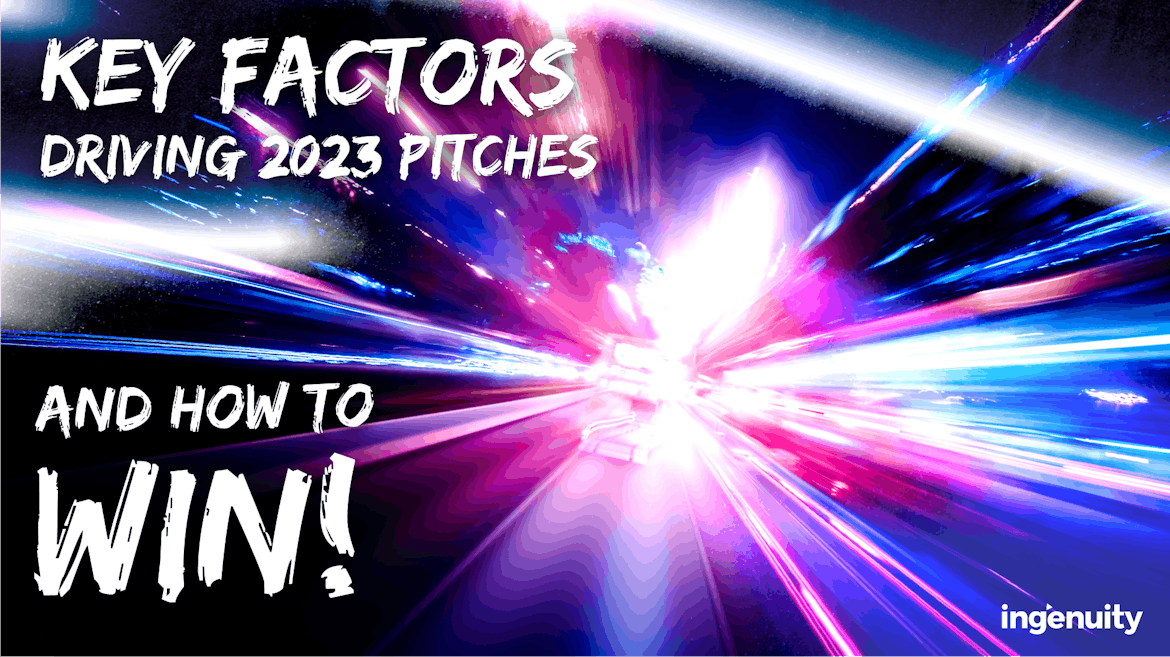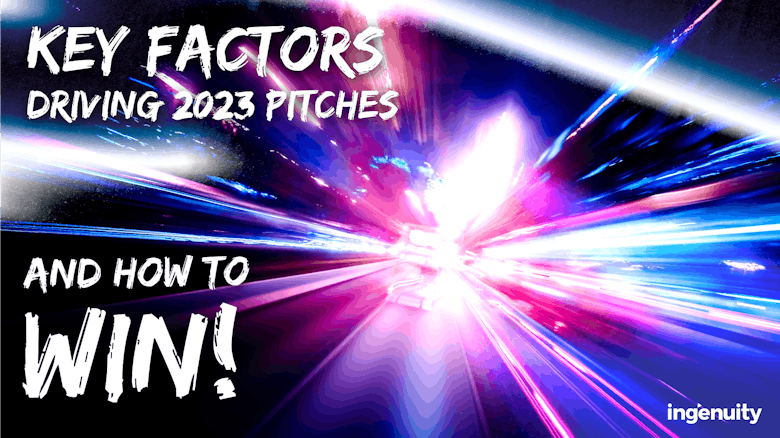
Key Factors Driving 2023 Pitches and How to WIN
Duncan WoodAfter 17 years working with brands of all shapes and sizes, we’ve narrowed down the top drivers of the new business/pitch market, particularly in the ‘creative’ space: brand optimism - economically, politically, and personally, dissatisfaction with existing agency relationships, new entrants to the market (start-ups/scale-ups), a belief that there is ‘something better out there’ and integrated vs specialists.
These are the key factors driving pitches in 2023, but what's driving the agency wins?
When it comes to finding the perfect partner, there are thousands of agencies in the UK alone. This can be overwhelming for brand marketers, especially when faced with a sonic wall of experts claiming to be able to do it all.
When it comes to the pitch, brands have several 60-minute sessions to choose a potential business partner that could alter the way their business moves, shakes, makes, breaks, or disrupts. It’s like saying yes to a huge relationship on a first date. Which I’m not sure is the ‘done thing’.
Unlike the world of dating however, where serial dating to find ‘the one’ is an acceptable pastime, company time and business resource is precious. So how can an agency better their chances of impressing the brand in the room?
Let's take a look.
Chemistry starts at home
I would like to reiterate that not only does ‘people matching’ - or pitch casting - pertain to agencies and clients, but also within your own team. You’d shoot yourself in the foot if you sent out a patched-together team that doesn’t gel and can’t get on the same page.
A team that can’t get on well with each other will stick out like a sore thumb, meaning the client won’t warm to the room, and any hope of finding a match is sizzled out before you’ve played your ace.
Agencies tend to place people together based on their job roles as opposed to what team members work well together. And remember: be mindful of diversity and inclusion. It matters.
Flex the Agenda
Every good meeting has an agenda. But do you stick with it or f*&%k with it when it comes to creating chemistry? The thing is, there’s no formula for chemistry - it’s there or it’s not. But you can create the right environment to give yourself the best shot at success.
A chemistry meeting agenda should be created with the view that deviation is important. There must be an element of flow; know which key points to hit, but equally don’t be afraid to veer off-topic. Most of the time, agencies that go beyond an agenda stand out much more than competitors.
An important side note: if the client has set an agenda, one that’s too-time consuming and geared to hit certain points, it’s imperative that an agency responds to those specific expectations from the get-go to have more chance of success in the first meeting.
Agencies, the longer the agenda, the harder the process tends to be.
When it comes to the content within the agenda, go beyond the brief. For example, a creative brief that mentions influencers, requires an influencer-based solution. But, what ELSE can you give them to halo their needs for this challenge? Notice something of value within the brief that isn’t mentioned; go beyond what they’re asking.
Research to the Max
After many years and many pitches, we understand the importance of agencies doing recon on the brands they want to impress. That includes gathering intelligence on the people who’ll be present in the room.
If the pitch comes through the intermediary (Ingenuity) route, you can lean on the middleperson for insight, and the low-down on the brand and attendees.
If the brief has come direct, then it’s up to you to polish those FBI skills to learn everything you can on your prospective business partners. That means research online, through contacts, LinkedIn, or via recent press interviews.
Virtual Meeting Prep
Take the time to properly set up - especially for virtual meetings.
Cue the theatrics: this is where you set the stage for the start and end to the meeting that you want. This is known as “pitch theatre”; nothing new or ground-breaking to anyone in our world, but a key area of focus nevertheless.
Now, we all know the state of the world for the past two years. With the pandemic came a digital shift, making it temporarily more difficult for in-person chemistry sessions to take place. However, we think we’ve cracked the code on making virtual meetings as chemistry-filled as possible:
- Make sure your team is on the call early, being fashionably late doesn’t apply here
- Wrap your heads around the agenda of the meeting - who needs to say what and when?
- If there is a presentation, wait until all introductions and intricacies are done before it’s put up.
- On the point of presenting, don’t keep the presentation up the entire time, take it down every few minutes.
- If you feel like you’re not going to get through everything as planned, it’s not an issue. Don’t speed up or rush. Communicate.
- Leave time at the end for the concluding conversation when chemistry can flow.
One thing I can attest to is the belief that there’s always common ground between people to set the tone, a niche area of interest that you can use to break the ice. It’s imperative that you highlight it early on, and thus the conversation that follows will flow with an air of ease and amicability. (Don’t force it though, don’t pretend you also like knitting if you don’t even know how to hold the sticks.)
In Person Prep
When it comes to face-to-face prep, don’t pick tiny rooms. It makes people feel restricted, especially after the pandemic. Allow specialists to take the lead and do most of the talking; don’t let the CEO or MD do it all. Use your experts and allow juniors to have the confidence to talk; clients love an underdog.
It’s 2023, so we need to be tech-savvy even when in person. Make sure your tech set-up is smooth, you haven’t misplaced the TV remote, and that the person in control is up to speed with navigating the presentation (if you have one).
There is a difference between jazz hands and passion. Make sure you drive the meeting with passion rather than just saying what you think clients want to hear. Let your guard down and show your emotional side - the part that really wants this piece of business.
And to finish, here’s the big secret to getting onto the top: if you’ve got some insights, give them out for free.
Give your pitch to everyone - not just the CEO
From an agency’s perspective, the instinct is to focus on and sell to the most powerful decision-maker in the room. If you’re an agency reading this, you might claim it’s not the case. But when you’re in that room, nerves naturally take over and the instinct to be drawn energetically to the most senior person ultimately kicks in.
With so much focus on diversity and inclusion of workforces, any senior client is likely to find it uncomfortable if you address them as the only person in a room full of his or her colleagues. If they’ve brought more junior employees along it’s because they want them to be included, and heavily rely on them for their opinions. If it’s a social brief targeting Gen Z, speak to the Gen Zs in the room. Focus your energy on everyone equally in the room and invite each person sitting in those seats into the conversation.
If you can give everyone a sense of purpose for attending the pitch, you’ll win over the most senior client just like that (providing the pitch is good too, of course). I can guarantee that the most junior person in the room will be asked what they thought of the session, so double down on making them feel valued. Schmooze juniors, and seniors will love you.
A final point to consider, relating to both people matching and social interaction, is matching seniority levels. If you’re meeting a whole bunch of C-Suite leaders with 60-plus years of joint experience, don’t bring your most junior team. And if you’re meeting juniors, don’t bring your leaders.
Match experience and treat everyone equally.
Subscribe to Ingenuity’s content hub
Receive the latest interviews, insights and trends straight to your mailbox.

